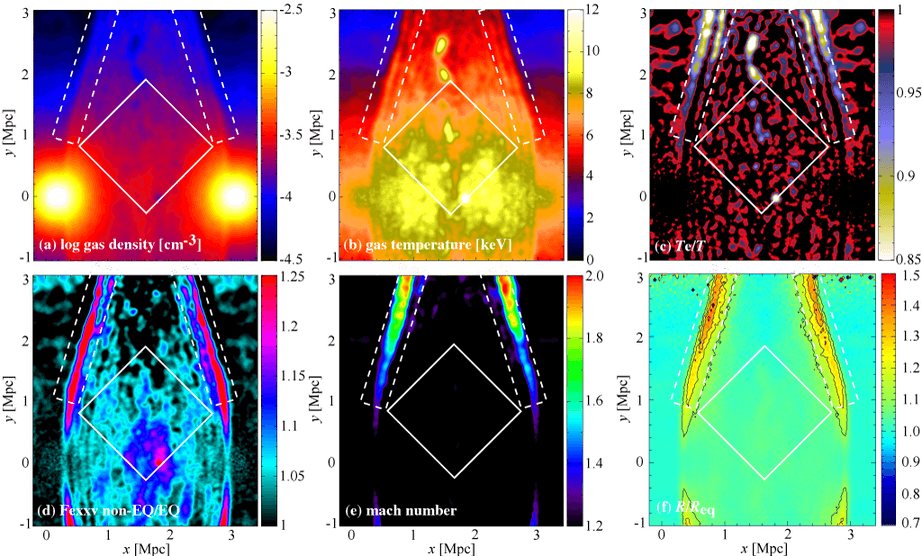Featured Articles
Non-Equilibrium Ionization State and Two-Temperature Structure in the Linked Region of Abell 399 and Abell 401
Takuya Akahori (Center for Computational Sciences, University of Tsukuba)
Kohji Yoshikawa (Center for Computational Sciences, University of Tsukuba)

Figure: Side-on view of galaxies colliding from the left and right. White solid square is a region that has already been observed by the Japanese X-ray satellite Suzaku (Fujita et al. 2008 PASJ, 60, S343), while the white dotted line shows the newly predicted region of the shock-front. The panels shows a slice in the plane of the collision of (a) gas density (b) gas average temperature (c) electron density / gas average temperature, (d) the fractional abundance of 24 times ionized iron (e) Mach number of the shock wave integrated along the line of sight (f) (6.6-6.7keV band / 6.9-7.0keV band) emission line intensity ratio.
Researchers Yoshikawa Kohji and Akahori Takuya have performed numerical simulations of two colliding galaxy clusters Abell 399 and Abell 401, and calculated the non-equilibrium ionization states of heavy elements in the linked region. The calculations reveal that the electron temperature and the ion temperature are not equal. They also found that there may be a shock front that has not yet been found in the observations at the end of the linked region. This work was published in the August issue of the Publications of the Astronomical Society of Japan (PASJ). Preprint
It is thought that galaxy clusters hare formed through the repeated collision and coalescence of small clusters of galaxies and galaxy groups. High-temperature ionized gas of several tens of million degrees accompanies clusters of galaxies, and the heating mechanisms may include shock waves and adiabatic compression that occurred during collision. These are important processes for converting thermal energy into the gravitational energy of the universe.
Detailed work
The ionized gas is observed by X-ray astronomy satellites constitutes electrons and ions. In thermal equilibrium state the electrons and ions have the same temperature, because the ionization and recombination rates are balanced. However, gas is subjected to rapid heating due to shock waves and compression, and it is often temporarily not in thermal equilibrium before relaxing to thermal equilibrium over a certain timescale. Since the density is low in galaxy clusters, especially at the edges, where collisions occur, the timescale of thermal relaxation may in fact be quite long and the plasma may persist in a phase of non-equilibrium ionization for a while.
We therefore carried out the first time in the world a three-dimensional numerical simulation of collision of galaxies using the supercomputer of the University of Tsukuba, to simultaneously solve the time evolution of the temperature states and ionization states of the gas as well as the motion of gas and dark matter. One result, which can be seein in Figure panel c) is that the electron temperature is low a few percent lower from the average gas temperature in the region where the two galaxies clusters are colliding. Another result is that the frational of 24 times ionized iron (Fexxv) is larger than the equilibrium value by 10-20% (Figure panel d). It was also shown that there may be shock front with a Mach number of 1.5-2.0 in the linked region, which has yet to be detected in the observation (Figure panel e). Here, there is a possibility that the intensity ratio of emission lines in iron Kαmay be observed at a value that is shifted by several 10% of the equilibrium value (Figure panel f).
Our model enables the precise estimation of the heavy element content by taking into account a non-thermal equilibrium state, which sheds light on heavy elements contamination from galaxies and the evolution of galaxies, as well as the existence of the cosmological shock. We can expect future, more detailed investigations of these phenomena with the Suzaku satellite and next-generation astronomy satellites.


 和 英
和 英